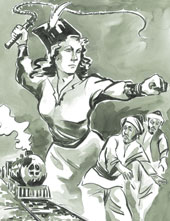 |
| Illustration by Suman Choudhury |
Revolution has many faces. In Bollywood, it came wearing an eye-mask, snapping a whip and beating up a bunch of baddies. The year was 1935, the film was Hunterwali. And the woman was Nadia.
The film?s super success spawned a huge merchandise of Hunterwali masks, whips and photographs in a way Harry Potter could hardly imagine. Long before Charlie?s Angels began cleaning the crime-ridden streets of the United States, India had its own on-screen avenging angel.
Even 70 years later, Nadia?s name continues to draw crowds. They don?t show her films in the theatres anymore, not even on television. But last Monday, during the launch of her biography, Fearless Nadia, by Dorothee Wenner, every seat was occupied in New Delhi?s Max Mueller Bhavan. College kids as well as old-timers were all there to watch Fearless: the Hunterwali Story, an hour-long documentary on her life, shown after the book-launch. The Nadia mystique endures.
The success of Nadia ? daughter of a British soldier and a Greek bellydancer ? as a Bollywood heroine has confounded film scholars. What made the audience, who in real-life would have preferred their womenfolk staying indoors, adore the male-bashing heroine is an interesting sociological riddle.
When Hunterwali was ready for release, exhibitors were wary of its content. At a time when the national movement was at its peak, they were cautious about showing a movie where a big, firang woman hoisted Indian men over her shoulder and flung them away like toys. Says Wenner, ?They were scared that the audience would tear down the cinema hall.?
The audience did bring the house down. But only out of sheer delight. Wenner, who fell in love with the Nadia persona after watching a documentary on the stunt queen in 1995 at the Berlin film festival, believes that the heroine?s white skin worked to her advantage. ?She was the perfect outsider; someone who could both be inside and outside at the same time,? says the German author.
Being a foreigner, Nadia wasn?t seen as a danger to the social status quo. She was not seen as an invader of homes, destroying time-honoured values, but as a vehicle for fantasy fulfilment. Perhaps, that?s why she was also wildly popular in the Arab world. Much of Nadia?s primary audience was the urban underclass: the tangewallah, the factory worker, the daily wage labourer. Film scholar Shohini Ghosh, however, points out that she always had ?a closet middle-class audience?, who watched her movies but were ashamed of admitting it. A fact that Girish Karnad affirms from relating personal experience in the book.
In her films, Nadia championed the underprivileged. While her muscular white body, Anglicised Hindi and outlandish dress ? tight white shorts, a small blouse and a cape ? created a whiff of the exotic, her films? content was native. Diamond Queen (1940) was a well-disguised clarion call for freedom; Bambaiwali (1941) cried out for women?s emancipation. Other movies such as Hurricane Hansa (1937) touched upon Hindu-Muslim unity. But, more importantly, hers was a battle against social and economic iniquities. Nadia was a desi female Robin Hood with a whip.
You don?t see Nadia in any form in Bollywood today. Sometimes, you can see glimpses of her in films such as Sri Devi?s Chalbaaz. ?But these modern characters come with certain compensations such as marriage so as not to offend or assault the existing notion of femininity. With Nadia, there was no such apology,? says Ghosh.
Trade analyst Komal Nahta proffers that an all-action venture with a female protagonist is seen as a risky venture by producers. But the argument can be challenged on two grounds. First, these days 90 per cent films flop anyway. Second, all-women Hollywood action flicks such as Charlie?s Angels and Lara Croft have been patronised by the multiplex audience.
Considering the audience?s positive reaction during the documentary, the return of Fearless Nadia could well be an idea whose time has come.

